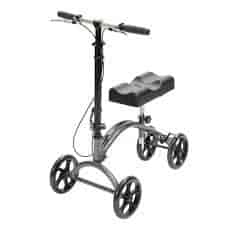An injury may leave you with the question, crutches or knee walker? Which is best for you? There are pros and cons to both devices, and many may find that either choice works well in improving mobility and access during recovery.
Your recovery from an injury or operation may depend on mobility devices to help you get around and rehabilitate. But which equipment is best for your distinct needs? Talk with the mobility experts at Pacific Mobility to choose the best option- that also works for your budget. Call today for a thorough needs assessment and consultation to get yourself on the road to recovery!
Crutches or knee walker? Which is best for you?
Crutches or a knee walker- it is a big decision. Know that either device will present you with a learning curve that requires practice and vigilance for new users. Take time and effort to learn the features and controls of both aids, and maneuvering your home and surroundings will become second nature. For the speediest recovery, stay off your feet as much as possible, and when you must get around, go to work, or complete an everyday task, use a mobility device for support. Before investing in either option, consider the pros and cons of both crutches and knee walkers to find which choice fits your lifestyle best.
Crutches
Crutches are a relatively inexpensive option during your rehabilitation and recovery, and it may be possible to rent a pair in some instances. Crutches can cause discomfort since you are putting all of your body weight on your under-arms, which may be irritating. Some other things to consider about crutches are:
-
You can really move
You can get around pretty-swiftly on crutches if you have some strength in your upper-body or core. Another perk: you will build up your arms, back, and core quite quickly when using crutches over time.
-
Crutches can hinder multi-tasking
When using crutches, you really won’t have the ability to carry, open, pick-up, or reach while moving. Crutches can also present some challenges when it comes to stairs.
-
Crutches are great exercise
As mentioned, walking with crutches can build muscle in your upper-body, but you can also get a pretty-good overall workout when using crutches and recuperating from an injury. This can hasten your recovery time, too. Win-win!
-
Crutches can be clumsy
Depending on your injury, you may find that you feel unsteady or wobbly when using crutches. Crutches can be difficult to keep upright, and you may find yourself constantly picking them up when they topple over.
Knee walkers
Knee walkers may be a viable option for those struggling with a leg injury or recovering from an operation. Typically, knee walkers cost more than crutches and they may be unstable if you lean too far on any side. Figuring out if a knee walker will work for you involves considering both the pros and cons of these clever walkers:
-
Knee walkers are sturdy and stable
Knee walkers have a lower center of gravity and are low to the floor which makes them stable. The cushion for your knee is comfy and soft, allowing you to take a break when resting your cast or injured leg. This also prevents you from putting weight on your injured leg, which can help with your recovery.
-
It can be a slow-go
Knee walkers take more time than crutches, and you may find challenges depending on the walker’s width. They can tread slowly on some surfaces, and stairs are a no-go. Narrow doors or hallways could present issues if your walker is wide.
-
Knee walkers do the work for you
Another perk of a knee walker is that you don’t have to be in tip-top shape, or have significant upper-body strength, to utilize and use your device. While you won’t build your body using a knee walker, you also won’t work up the sweat that you might with crutches. Once you have familiarized yourself with the operation and features, you can move along quite consistently. Furthermore, it a hands-free operation, which could improve your ability to multi-task.
-
There is less of a fall-risk with knee walkers
Knee walkers are less likely to slip on ice or wet surfaces than crutches, and they seem a bit smoother in use. One wrong step on crutches could exacerbate injuries, while this risk is diminished when using a knee walker during your recovery.
Life doesn’t stop when you sustain an injury or need surgery, and mobility aids may be the most viable solution to everyday life. Making the choice between crutches and a knee walker may seem insignificant, but it is a decision that can impact your ease, access, and comfort during recovery from an injury or operation. Talk to the experts at Pacific Mobility to learn more about obtaining equipment, devices, and aids to improve your overall quality of life.
President, Husband, Father, Grandfather Graduate of UC Davis- Bio Sci Major- Go Aggies! Jeff has extensive experience in all of Pacific Mobility’s products and services, and specializes in accessibility products as well as stairlifts, ceiling lifts and custom wheel chairs. His hobbies include spending time with family, gardening, mountain biking, exercising and off road motorcycle riding.
24 years as Owner/President of Pacific Mobility Center – selling, installing, and servicing stairlifts, porch lifts, ceiling lifts, pool lifts, handicap ramping, specialty wheelchairs, scooters, power wheel chairs, and other power mobility devices
Certified Environmental Access Consultant since 2008
Licensed General Contractor since 1998
Certified Aging in Place Specialist since 2016
Board Member for Home Access Professionals
Member of Association of Members of the Accessibility Equipment Industry (AEMA)




